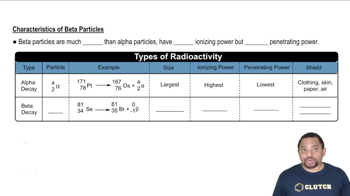Radioactive Decay
Radioactive decay is the process by which unstable atomic nuclei lose energy by emitting radiation. This can occur in various forms, including alpha (α) and beta (β) decay. Understanding the type of decay is crucial for predicting the products and the number of particles emitted during the decay process.
Recommended video:
Rate of Radioactive Decay
Alpha and Beta Particles
Alpha particles consist of two protons and two neutrons, making them relatively heavy and positively charged. They are emitted during alpha decay, resulting in a decrease in the atomic number by two. Beta particles, on the other hand, are high-energy, high-speed electrons or positrons emitted during beta decay, which changes a neutron into a proton or vice versa, affecting the atomic number by one.
Recommended video:
Characteristics of Beta Particles
Decay Series
A decay series is a sequence of radioactive decay processes that an unstable nucleus undergoes until it reaches a stable state. Each step in the series can involve different types of decay, leading to the production of various daughter isotopes. Analyzing the decay series of neptunium-237 to bismuth-209 helps determine the total number of alpha and beta particles emitted throughout the entire decay process.
Recommended video:
 Verified step by step guidance
Verified step by step guidance

